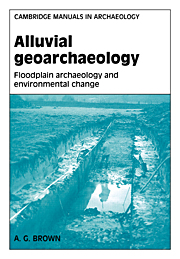Book contents
- Frontmatter
- Contents
- List of illustrations
- List of tables
- Preface
- Acknowledgements
- Introduction and the example of the Nile
- PART I PRINCIPLES
- PART II APPLICATION
- 5 Artifacts from floodplains and rivers
- 6 The rise and fall of forested floodplains in North-West Europe
- 7 Buried sites
- 8 Managed floodplains
- 9 The cultural archaeology of floodplains
- 10 People, floodplains and environmental change
- APPENDICES
- References
- Subject Index
- Index of rivers and sites
9 - The cultural archaeology of floodplains
Published online by Cambridge University Press: 03 December 2009
- Frontmatter
- Contents
- List of illustrations
- List of tables
- Preface
- Acknowledgements
- Introduction and the example of the Nile
- PART I PRINCIPLES
- PART II APPLICATION
- 5 Artifacts from floodplains and rivers
- 6 The rise and fall of forested floodplains in North-West Europe
- 7 Buried sites
- 8 Managed floodplains
- 9 The cultural archaeology of floodplains
- 10 People, floodplains and environmental change
- APPENDICES
- References
- Subject Index
- Index of rivers and sites
Summary
The last chapter outlined the impact of humans on the floodplain system through the management and control of floodplain resources. This begs several questions; were floodplains preferentially settled and if so why, and how have people coped with the negative as well as positive aspects of floodplain locations? This chapter explores these questions and the data that archaeology can generate that can be used to test such hypotheses and other hypotheses concerning relationships between culture and environment. Floodplains not only have particular sets of positive and negative resources (in the widest sense) but also may have ritual or mythic significance – all of which is part of the cultural archaeology of floodplains.
Locational data and alluvial environments
Any explanatory theory of the location for any activity, excluding enforcement but including inertia, must relate to the perceived advantages and disadvantages of that location as opposed to other locations. When we are dealing with a single or primary site function (such as mining), this seems obvious, but in reality this is rarely, if ever, the case. Even when there was no relocation decision, as is implied by the occurrence of continuously occupied multi-period sites, the perception of positive and negative factors is important in preventing abandonment. This is especially true in the case of dynamic, or hazardous, environments, such as steep slopes, volcanoes and floodplains.
- Type
- Chapter
- Information
- Alluvial GeoarchaeologyFloodplain Archaeology and Environmental Change, pp. 279 - 303Publisher: Cambridge University PressPrint publication year: 1997



